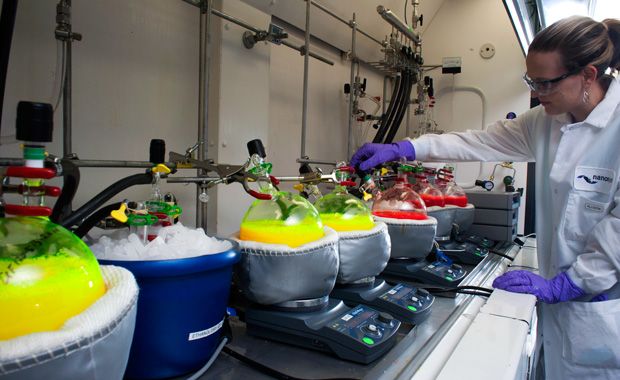At Display Week 2014, high-efficiency quantum dots sharpen colors

Rumpelstiltskin had the admirable ability to convert low-cost straw into valuable gold. Today, display manufacturers are starting to reap the benefits of their own photonic alchemy, converting the light from cheap sources into the precise wavelengths needed for more efficient displays that can show sharper colors.
This magic is accomplished using what are known as quantum dots. These are semiconductor nanocrystals that exhibit a range of unusual electrical and optical properties, but for decades they were largely confined to research laboratories. Now, quantum dots are being used in mass-produced displays for the consumer market, including such items as Sony flat-screen televisions and Amazon.com’s Kindle Fire HDX e-reader. And the field is still rapidly growing and evolving. At the Display Week 2014 conference of the Society for Information Display this past June in San Diego, quantum dots were a hot topic, both in the exhibit hall and in presented papers; the symposium schedule included three separate sessions dedicated to the subject.
Quantum dots have many interesting properties, but when it comes to displays the most important thing about them is that they can absorb light of short (blue) wavelengths and then emit it as light of longer (red and green) wavelengths. This might sound a lot like traditional phosphor materials, which made the cathode ray tube (CRT) possible by converting a beam of electrons into visible colors. The difference is that quantum dots produce much more precise emissions. A good phosphor has an emission range of about 50 nanometers, while a typical quantum dot’s range is about half that. Just where on the spectrum that range is can be carefully controlled by varying the size of the particles; the larger the particle, the longer the wavelength of the emissions will be. The peak emissions of the quantum dot can be tuned to within 1 nm. This gives excellent control over the color output of the display.
And conveniently, while quantum dots can emit a very narrow range of wavelengths, the light source they are converting from can have a broader range and the light will still be converted with an efficiency of more than 95 percent. All this helps make quantum dots much less wasteful than traditional backlight approaches, where a lot of light is lost in a color-filter layer that screens out undesirable wavelengths. With more of the light getting to the viewer, the result is a display that is brighter without upping power consumption.
Color reproduction has become an increasingly important topic in the display industry. For years, CRT quality was considered “good enough,” even though the typical CRT display was able to show only about 70 to 75 percent of the gamut of colors specified in the National Television System Committee (NTSC) color standard.

Advances in color displays—first with LCDs and more recently with OLEDs—have made it possible to exceed the boundaries of the NTSC standard. Consequently, expanded color-gamut standards have come into play, the most recent of which is ITU-R Recommendation BT.2020, created by theInternational Telecommunication Union to measure the color space used by next-generation ultrahigh-definition (UHD) televisions. Some prototype quantum-dot-based displays can already reproduce 95 percent of the color gamut specified by Rec. 2020.
Two companies have taken the lead in commercializing quantum-dot technology. QD Vision is the company behind Sony’s Triluminus technology, and Nanosys has partnered with 3M Co. to create Quantum Dot Enhancement Film (QDEF), a light-processing film.
The QD Vision approach adds quantum dots to strips of blue LED edge lights around an LCD panel. Some of this light is converted to red and green, which is mixed by a light guide to create a high-quality white backlight for the LCD panel’s color subpixels. The Nanosys/3M approach places the QDEF film over the back of the panel, and then a blue LED backlight is applied (typically through edge lighting and a light guide). Some of the blue light is converted in the film layer to red and green light before reaching a subpixel.
A new, third, approach is being developed by a number of researchers. This involves putting the quantum dots directly on the blue LED chip. This can simplify the optical and light-management requirements, but it subjects the quantum-dot material to higher operating temperatures that can decrease performance.
As you might expect, a technology that simultaneously increases color performance and power efficiency is attracting a lot of commercial interest. New products continue to appear; at Display Week, Asus announced theZenbook NX500, the first high-gamut 4K-resolution notebook computer, which uses 3M’s QDEF quantum-dot film.
Market research firm IHS projects that the market for displays that incorporate quantum dots will grow from about US $10 million in 2013 to $200 million by 2020. And according to Touch Display Research, the quantum-dot materials market is projected to grow from $70 million in 2013 to $9.6 billion in 2023.
One problem with quantum dots is that they require cadmium, which is on the European Union’s Restriction of Hazardous Substances (RoHS) regulation list. However, researchers are working on creating cadmium-free quantum dots. Dow Electronic Materials has licensed technology from Nanoco Group to produce such materials; commercial production is slated to start this year.
In any case, it appears that quantum dots will play an important role in the new UHD television market, while helping LCD panels compete more effectively with OLEDs for a broader range of devices. The end result will be that you’ll see colors on the screen that until now you’ve seen only in real life.


No comments:
Post a Comment